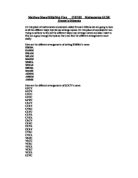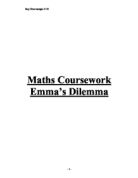Now that we have crossed out the duplicates we can create a new table:
We can now see that there are actually 12 combinations in EMMA.
Analysis
- After analysing these two results, I have noticed a few things:
- The obvious thing to notice is that there are fewer combinations in the word Emma because of the fact there are two M’s in it. This means that many combinations are cut out of the total count, as shown above.
- Taking this idea further, we can also see that the amounts of combinations in Emma are exactly half the amount of Lucy. However, this analysis could be mathematical or incidental, we do not know for sure, but it something to watch out for.
Using this methodical method is ok for words such as Lucy and Emma, but in another case such as a six-letter word, it would take very long and be extremely inconvenient. Therefore, a method must be found to make this process quicker and easier.
I am going to do this by experimenting with combinations of different amounts of letters, and see if any pattern emerges. I will use 1, 2, 3 and 4 letters, and put the results in a table.
1 letter: A
A: 1 combination (1x1)
2 letters: A/B
AB,BA: 2 combinations (2x1)
3 letters: A/B/C
Here we have three starting letters (A,B and C). We can do this systematically. We start with A. Now, because we have written A, we know that there can only be two more letters which go next, B and C. We also know from our previous case that with 2 letters, there are 2 combinations. We can also do this with the other two starting letters (B and C). So now we have three starting letters with two other letters following them (which can be rearranged). So in conclusion, we have 3 starting letters and 2 combinations for each one. So it’s 3x2x1=6 combinations
All letters in brackets can be rearranged
4 letters: A/B/C/D
The same method is required her, except now there is another letter (D). But we still follow the same procedures. There are four starting letters (A,B,C and D), and three letters which go with them. And from our last case we already know that with three letters, there are 6 combinations (3x2x1). So now, we just multiply this by 4
4x3x2x1 (or 4 multiplied by 6) =24 combinations
Letters in brackets can be rearranged
I have created a table showing my results:
4x3x2x1 is known as 4! (four factorial). This is shown on the graph above. Therefore, we can now calculate the number of arrangements for the next amount of letters. So if we wanted to know how many combinations there were for a five letter word we would just carry the pattern on. We would do 5x4x3x2x1, or 24x5, which equals 120. We can expand this though and give this complete pattern a formula: n! (n factorial)*
*n= total number of letters in the word
- - - - - - - - - - - - - - - - -
We have now come onto a new part of this coursework, where I will be looking at cases where the same letters are repeated.
1. Firstly, I will be looking at cases where two letters are the same and all else are different, and the combinations which go with them. What I mean by this is I will be looking at example words with letters such as AA and BB (2 letters the same), which then could follow by any other letter (for example C or D)
2. I will then move onto looking at cases where one letter is repeated many times. For example AAAB (‘A’ is repeated many times). I will then create two tables, showing the results of both the investigations next to the results I have already found (cases when all letters are different) and see if any pattern arises.
Case Study 1 (2 letters same, all else different)
I will start by looking at just one pair of the same letter, with nothing following it:
2 letters:
A/A
A 1 combination
We will now move onto looking at the same pair but with another letter(s) following it:
3 letters:
A/A/B
AAB
ABA
BAA 3 combinations
4 Letters:
A/A/B/C
AABC
AACB
ABCA
ABAC
ACBA
ACAB
BAAC
BACA
BCCA
CAAB
CABA
CBAA
12 combinations
(2 pairs of 2 different letters)
I will now look at two pairs of 2 different letters with nothing following it:
4 letters:
A/A/B/B
AABB
ABAB
ABBA
BABA
BAAB
BBAA 6 combinations
I will now look at the same case, but with a letter following it:
5 letters:
A/A/B/B/C
AABBC
AABCB
AACBB
ABBAC
ABBCA
ABCAB
ABCBA
ABABC
ABACB
ACBBA
ACBAB
ACABB
(12) (12) (6) = 30 combinations
I used the same systematic method as before to find these results. I have also come across another analysis. I also came across another analysis. In the first and second column, I came across one combination in which the last three letters were all different and we know from our previous investigations (in which all letters were different) than when there are three letters which are different, there must be exactly 6 combinations for them. These six are all highlighted in BOLD.
30 combinations
I will now create a table to display me results, and see if any pattern arises:
Case Study 1 Results:
- The numbers in red are the amounts of combinations for that case
Here we can see a pattern. We can see here that when another pair of the same letter comes into the case, the result is exactly half than what it was before the pair was added (shown in bold RED).
Why this works
Explaining why this works is difficult, so I will use the help of the previous studies to explain. Think of it like this:
- If you have a word consisting of four different letters, L, U, C and Y, to find the combinations, we will need to go through all the four letters, as they all have different combinations.
- However, if we have a word such as Emma, consisting of E, M, M and A, we do the same thing, find all the combinations. So we would go through all the letters, on by one, E, then M, then M, and finally A. However, because one of the letters are repeated (M), finding the combinations which go with this would be unnecessary as we would just get the exact same results as finding the combinations of the first M. And we know from the tables before, that finding the combinations is exactly half when all the duplicate results are cut out. Therefore, I have proven that this formula works.
Now that we know this works, we can predict what the next results will be:
The figures in blue are following this formula, showing what will come next, if this formula is used. We know from previous investigations that to find the combinations for all five letters being all different is 5! (five factorial). We then divide that by two to find the next column, and divide that by two again, to find the last column.
Case Study 2 (1 letter repeated many times)
Now I am going to look at cases where 1 letter is repeated many times. Now, we could start with looking at a case where one letter is repeated twice, however this is already been done. As we can see from above, one letter repeated twice is the same as one pair of the same letter. So this is already out of the way. This means we will start with one letter being repeated three times, with nothing after it:
1 letter repeated 3 times:
A/A/A
AAA 1 combinations
Now we will put something in front of this, and see if anything changes:
1 letter repeated 3 times + 1 different letter:
A/A/A/B
AAAB
AABA
ABAA
BAAA 4 combinations
I used the same systematic method as I did for all the other cases as I did for this, but when I had finished it, I saw something quite interesting. Because there is only one different letter in this (B), all that is really happening is the B is moving along the letters (highlighted in BLUE).
I will now look at a case where two letters are after of the repeated letters:
1 letter repeated 3 times + 2 different letters:
A/A/A/B/C
AAABC
AAACB
AACBA
AACAB
AABCA
AABAC
ABAAC
ABACA
ABCAA
ACAAB
ACABA
ACBAA
Next, we will be looking at one letter being repeated more than three times. We will look at one letter being repeated four times, with nothing after it, and then with something after.
1 letter repeated 4 times:
A/A/A/A
AAAA 1 combination
1 letter repeated 4 times + 1 different letter:
A/A/A/A/B
AAAB
AABA
ABAA
BAAA 4 combinations
We will now move on to looking at one letter bring repeated five times:
1 letter repeated 5 times:
A/A/A/A/A
AAAAA 1 combination
1 letter repeated 5 times + 1 different letter:
A/A/A/A/A/B
AAAAB
AAABA
AABAA
ABAAA
BAAAA 5 combinations
My results are shown in the table below:







